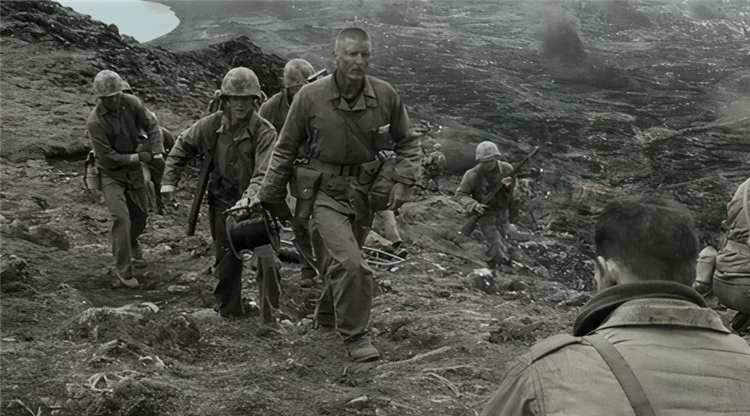Clint Eastwood’s Flags of Our Fathers earns a glowing review from a historian for its portrayal of the Battle of Iwo Jima. Released in 2006, Flags of Our Fathers explores the American experience of the iconic World War II battle, and serves as a sister film to Eastwood’s Letters from Iwo Jima (2006). Flags of Our Fathers, which stars Ryan Phillippe, Barry Pepper, Joseph Cross, and Adam Beach, focuses specifically on the lives of the men who raised the flag on Mount Suribachi, as is captured in an iconic photograph, with early sections of the movie featuring intense beach combat.
In a recent video for Insider, historian John McManus analyzes select scenes from Flags of Our Fathers’ Battle of Iwo Jima sequences, awarding the film a perfect grade for historical accuracy. According to McManus, the film accurately portrays Iwo Jima’s unique volcanic ash soil and the trouble it caused the Marines landing on the beach, but it also gets other details right regarding the use of fighter aircraft against fortifications on Mount Suribachi and how Marines handle and use grenades. Check out McManus’ comments below:
“I think this really portrays the sort of deadliness of those initial moments at Iwo Jima and they show how vulnerable they are at the waterline. You see that little gun team there that’s trying to get their gun off the boat, and they just end up in this machine gun position’s kill zone. They way the machine guns are camouflaged, the way they are fortified in there, I think is dead on.
“Two Marines trying to push a Jeep, and it just looks miserable, doesn’t it? That is directly taken from a photograph of the Battle of Iwo Jima. Volcanic ash, soil, and all this is really, really thick. So it’s easy for a vehicle to get bogged down there.

“The volcanic ash soil of Iwo Jima, I don’t know how they did this so well, but they did. You can imagine trying to dig into that. The soil was so ashy that it was hard to keep it stable enough in order to have a foxhole the way it would if you were digging into clay or mud, or whatever it would be, or dirt. It would just sort of backfill in and you’d just be in this indentation there.
“Any aircraft that’s strafing is probably using its main machine guns or sometimes, in some cases, rockets, to come in on some kind of position they’ve identified and just annihilate it with that weaponry the best they can. Those two aircraft you see heading towards Mount Suribachi, they’re not hanging around.
“You see the tracer rounds and all this, I mean it’s really well done. The smoke that obscures it for a while. I just think that’s extremely well done.
“The guy drops the grenade and he rolls over on the side in the other direction, sort of away from it, and that’s exactly the way you would’ve been taught. Generally, the American grenades had about a three-and-a-half to four-and-a-half second fuse. You would’ve been taught to arm the grenade, count off most of that, probably three seconds, and then toss it in and then get out of the way.
“ I’m rating this one a 10 out of 10 because I just really like the feel and look of the position, and what a bloodbath this whole thing is, I think is very well portrayed.”
What Flags Of Our Fathers’ Historical Accuracy Means For The Film
How The Clint Eastwood Movie Fared With Audiences & Critics

Flags of Our Fathers may feature a great deal of historical accuracy, but that didn’t help the film succeed with audiences. Made on an estimated budget of $55 million, Eastwood’s movie grossed only $65.9 million worldwide, making it a disappointment. Critically, the movie fared better, with Flags of Our Fathers currently sporting a 76% on Rotten Tomatoes, indicating generally positive reviews. The audience score, however, is more lukewarm at only 69%.
While Eastwood’s movie may fare well on a technical level and in terms of its authenticity to the Battle of Iwo Jima, it’s clear that the storytelling may be where the film’s faults lie. Much of the movie takes place on Iwo Jima itself, but long stretches also follow key characters after they return home, and it’s these sections where the intensity dies down and quiet character work becomes more important. The movie’s poor box office also suggests that interest in the Battle of Iwo Jima just may not be particularly high among audiences in general.
Our Take On Flags Of Our Fathers’ Historical Accuracy
Why Letters From Iwo Jima Is Better
Between Eastwood’s two Iwo Jima-based World War II films, I much prefer Letters From Iwo Jima, as the human story at the center of that one is arguably more intimate, more moving, and weaved more seamlessly into the narrative. That being said, Eastwood’s commitment to historical accuracy and getting details right that perhaps only history buffs will notice is certainly commendable.
Historical authenticity alone isn’t enough to save a movie with either critics or audiences, but Flags of Our Fathers still remains an interesting and perhaps underrated entry in Eastwood’s filmography. Plus, the Battle of Iwo Jima itself hasn’t been explored in many recent movies, meaning Eastwood’s sister films fill a unique gap in the historical movie landscape.
